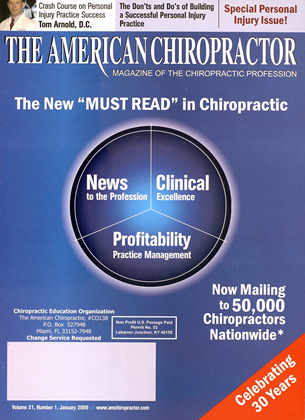bv Daniel J. Osborne, M.S. Dear TAC, I read with interest the article in the September 2008 edition of The American C hiropractor titled "Deal with Investigators from a Position of Strength," written by a chiropractor in the Minneapolis-St Paul area, reporting he offered the article as an illustration of how a strong and reasoned approach based on solid coding and documentation, coupled with a willingness to listen, can help doctors hold the line against contested claims and develop positive relational experiences with payer personnel. The author's actions would do little to facilitate a position of strength, with either Farmers or any other insurance carrier. The article, in my opinion, fails to live up to its title. From my perspective, as an investigator. I would suggest the title. "How to Paint a Target on a Provider's Back." Any goodwill the author may have developed with the Farmers investigator was likely dissipated by his article. Rather than holding-the-line, the author proposed a compromising course of action: 1. He does not meet with investiga tors or lawyers! Knowing when and when not to meet with investigators ami lawyers is a critical determinant! Experience has shown that, under the right circumstances, providers who meet with claims-handlers and fraud- investigators to discuss genuine con cerns regarding submitted claims are able to communicate more effectively regarding what the provider did, why the provider did it. etc. Such discus sions frequently resolve any issues or misunderstandings regarding clinical and billing activity. Additionally, such meetings frequently facilitate pay ment. An across-the-board refusal to meet with investigators is a red-flag to investigators, suggesting that the pro vider is hiding something. Heightened suspicion may entice more in-depth and expanded investigations. 2. He does not use (non-weight bear- ing) X-rays taken by other health care providers! He may soon be faced with questions from investigators on this activity, including: Has he ever not taken X-rays and used existing X-ravs for patients who had limited or no chiropractic coverage (e.g., Medicare, cash)? Does he request and review the X-ravs taken elsewhere immediately after an accident? If not. why not? 3. He purports to bill $200 per visit when performing therapy codes for around five minutes each, billing each service at $50, knowing they were billed in excessive amounts! Could this chiropractor be /deed with future questions as to the clinical rele vance of therapy senices administered only for Jive minutes; is the billing of multiple units of time-based therapies not administered for fifteen minutes consistent with correct coding conven tions; should such activity have been billed by reporting only one unit of the primary therapy administered? 4. He documents the care being given to patients on the HCFA 1500 claim form! Health care services are not documented on claim forms. Further, the claim form is CMS 1500, not HCFA 1500. and has been for years. Could this simple misstep be used by investi gators to infer that the provider does not have a strong understanding of the laws and rules? 5. He reports the fraud investigator from Farmers Insurance indicated that Farmers should send more of their clients to him! / suspect that Farmers Insurance, after their review of the article, will want to examine this claim very closely. In my many years of working around the Insurance and Health Care Professions, I have never heard of an insurance company investigator referring to an insured or a claimant as a "client. " Is the article analogous to bringing a knife to a gun-fight? The author indicates that he credits a consulting group with strengthening his practice and resolve in maintaining his position under challenge. It would be quite interesting to review the consultant's response to the author's advice. Whether the consultant responds is irrelevant. The author's position is likely to be put to the test very soon! Daniel J. Osbome, M.S., is an expert on health tare fraud issues and a recognized authority on health care compliance. He can be contacted at Chiropractic Compliance Consultants, Inc., 18065 238th Street, Tonganoxie. Kansas 66086:1- 913-369-9000: or www.cccpfc.com. Author Dr. Stephen Nohava Responds My article in the September issue of The American Chiropractor ["Deal with Investigators from a Position of Strength"] recounted a single incident that I felt demonstrated an important point: When charges for treatment are supported by proper coding and documentation, the doctor can submit them with confidence. The dialog, obviously paraphrased, digests a process wherein an initial stand-off evolved to a climate of mutual respect and a successful outcome for both parties. The "position of strength" is established by sound coding and documentation practices that enable doctors to maintain their policies—for example, that medical information requests be submitted in writing—and stand their ground effectively when challenged. The article is not intended to be instructive beyond this central issue. If Mr. Osborne chooses to take away a broader message than is intended, that is certainly his right, but any inferences he draws are strictly his own. To doctors. I simply say that, if you back down because you lack confidence in your coding and documentation, get some help. Stephen P. Nohava, D. C. LETTERS TO THE EDITOR E-mail: [email protected]
 View Full Issue
View Full Issue






